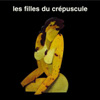 Although not quite as celebrated as Factory, this Belgian imprint initially shared many of the same artists and was very nearly the equal of its Manchester friends in terms of style and eccentricity (they put Current 93 on a damn Christmas album in 1984, for example). This compilation, however, mostly avoids the label's bigger names and focuses solely on the lesser-known (and poppier) female half of the Crépuscule roster. Despite containing a few artists best left forgotten and ample evidence of a rabid, but thankfully short-lived fascination with Bossa Nova, there are more hits than misses here and quite a few obscure surprises.
Although not quite as celebrated as Factory, this Belgian imprint initially shared many of the same artists and was very nearly the equal of its Manchester friends in terms of style and eccentricity (they put Current 93 on a damn Christmas album in 1984, for example). This compilation, however, mostly avoids the label's bigger names and focuses solely on the lesser-known (and poppier) female half of the Crépuscule roster. Despite containing a few artists best left forgotten and ample evidence of a rabid, but thankfully short-lived fascination with Bossa Nova, there are more hits than misses here and quite a few obscure surprises.
While it is hopeless to try to identify a "Crépuscule sound," many of the best pieces included here fall quite squarely into the realm of breathy, sexy synthpop.Probably the most endearing of the lot are French duo Mikado, whose languid "Romance" burbles and throbs along quite seductively.New York’s Thick Pigeon, comprised of dancer Stanton Miranda and frequent Coen brothers soundtrack composer Carter Burwell, also contribute a pretty stellar song - and some charmingly unconventional percussion - with "Dog."There are a number of other likable synthpop works included as well, but most of them adhere much more closely to the pervading pop and club trends of the period and don’t stand out as much.
When the compilation drifts into other stylistic territory, however, the results vary and get rather…interesting.Cecile Bruynoghe’s performance of Erik Satie's "Gymnopedie No.1" is quite pleasant, but seems wildly out of place surrounded by pop songs.Les Disques du Crépescule actually had a pretty impressive track record with classical music though, releasing works by Glenn Branca, Michael Nyman, and Gavin Bryars, so Bruynoghe's inclusion is understandable in the larger context."Boy, I’m Just Getting Over You" by Jane Kelly Williams is markedly less so, however, sounding like tame '90s American adult contemporary folk-pop à la Shawn Colvin.Paradoxically, the swinging retro vocal-jazz of The French Impressionists doesn’t sound much out of place at all, simply because "exotic" influences like Latin jazz, Bossa Nova, and '60s French pop are liberally slathered all over this album.In general, unfortunately, the jazzier pieces have not aged particularly well.I am very happy that this particular trend exhausted itself before it had a chance to completely destroy European indie music.
There are also a number of freak pieces that don't quite sound like anything else around.I wasn't particularly impressed with Snakefarm's attempt to update traditional American folk for the trip-hop set, but Isabelle Antena turns in two utterly bizarre and memorable songs.The first comes courtesy of her band Antena, who contribute a gleefully deranged-sounding dub détournement of Antõnio Carlos Jobim's "The Girl From Ipanema."The other one is from her Powaga Sisters project, who turn Patrick Coutin's hit "J'aime Regarder Des Filles" into an intense funk work-out that calls to mind Prince's "Kiss."Unfortunately, her own solo piece on the album—the Swing-out Sister-esque "Be Pop"—makes me want to claw my ears off when it reaches its "boop boop ee doo" scat chorus.Still, two of out of three isn't too shabby.
Perhaps owing to the fact that life in '80s Belgium was probably quite a bit more pleasant than that in Manchester, there is not much in the way of darkness and angst here aside from the Banshees-esque goth-pop of Brussels' own Isolation Ward.Germany's Malaria! are usually good for some angular vitriol as well, but their "You You" contribution is surprisingly bouncy and hook-heavy (aside from the unwaveringly intense vocals, anyway). There is an insightful quote in the liner notes from Ludus's Linder Sterling, who notes: "there's this particularly soporific atmosphere about Brussels…there was something about that level of comfort, and a real sense of disconnection.Everything seemed to slow right down…we just couldn't create there."
Given the uneven quality of Les Filles Du Crépescule, it is tempting to snarkily suggest that many other artists seem to have suffered the same fate, but that wouldn't be quite fair:the emphasis just seemed to shift from emotion and gut-level power towards style and experimentation.Notably, many of the musicians here doubled as visual artists/actresses/dancers/serious composers, which seems to have resulted in a richly integrated and very cerebral scene (and some great album art).Some of this music definitely sounds hopelessly dated or trendy today, but quite a bit of it is still fun and unconventional too.The occasional rough patches make the album pretty hard to get through in its entirety, but it is well-worth checking out for the handful of great, hard-to-find singles in its midst.
Samples:
- Mikado, "Romance"
- Antena, "The Boy From Ipanema"
- Thick Pigeon, "Dog"
Read More

